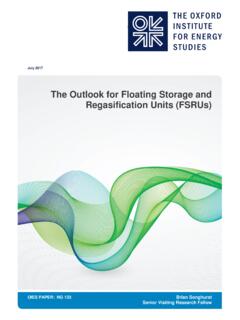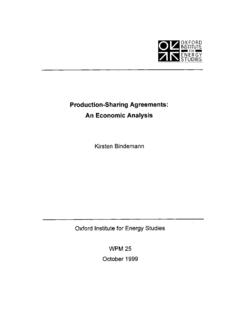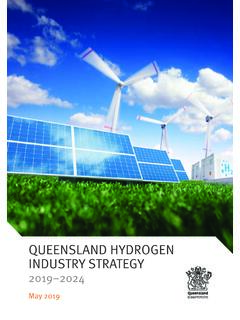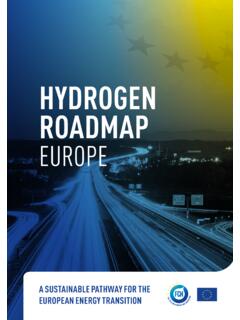Transcription of THE ROLE OF HYDROGEN IN THE ENERGY TRANSITION
1 May 2021: ISSUE 127. THE ROLE OF HYDROGEN IN THE ENERGY TRANSITION . Introduction .. 1. Martin Lambert .. 1. Opportunities and challenges for HYDROGEN in a decarbonized ENERGY system .. 3. Adam Hawkes .. 3. Can Power-to-ammonia provide grid flexibility? .. 7. Aliaksei Patonia and Rahmat Poudineh .. 7. The role of ammonia and HYDROGEN in meeting International Maritime Organization targets for decarbonizing shipping .. 11. Bruce Moore .. 11. HYDROGEN Blending Lessons from HyDeploy .. 17. Tommy Isaac and Andy Lewis .. 17. HYDROGEN and the decarbonization of steelmaking .. 22. Markus Sch ffel .. 22. Regulation of HYDROGEN markets are concerns about lock-in' effects valid?.. 26. Alex Barnes .. 26. How a traded HYDROGEN market might develop lessons from the natural gas industry.
2 31. Patrick Heather .. 31. The Role of HYDROGEN in Japan's ENERGY TRANSITION Towards 2050 Carbon Neutrality .. 36. Ken Koyama .. 36. Australia's approach to HYDROGEN domestic use vs exports .. 39. David Norman and Peter 39. Saudi Aramco's perspectives on HYDROGEN : opportunities and challenges .. 44. Ahmad O. Al Khowaiter and Yasser M. Mufti .. 44. HYDROGEN in the United Arab Emirates .. 48. Robin Mills .. 48. A US Perspective: The Potential of HYDROGEN Rests in its Diversity .. 52. Ken Medlock .. 52. China's emerging HYDROGEN strategy and the 2060 net zero commitment .. 56. Michal Meidan .. 56. CONTRIBUTORS TO THIS ISSUE .. 57. May 2021: ISSUE 127. INTRODUCTION. Martin Lambert The last two years (2019 and 2020) have seen growing momentum behind the global recognition of the urgency of the climate emergency', with more and more countries committing to achieve net zero emissions, typically by 2050 ( UK, European Union, Japan, and South Korea) and by 2060 in the hugely significant case of China.
3 The same two years have also seen a growing conviction that HYDROGEN will play a significant role in the decarbonisation of the ENERGY system. Electrification will certainly play a much enlarged role in future, with many commentators suggesting that the share of electricity in final consumption is likely to rise from typically around 20 per cent today to around 50 per cent by 2050. Even if that proves to be an underestimate, it will still leave considerable demand for low-carbon molecules, and, with current technologies , the most likely low-carbon (or preferably zero-carbon) molecule is HYDROGEN . A growing number of countries have now published national HYDROGEN strategies, and more such strategies are under development. These strategies set bold ambitions for development of HYDROGEN but are relatively unclear on the pathways and steps to reach those ambitions.
4 The scale of transformation of the ENERGY system from one based largely on fossil fuels to one where fossil fuels play a very minor role is enormous, and to complete such a transformation within 30 years requires unprecedented speed. Low-carbon HYDROGEN is starting from a small base, and current costs do not support a commercial business case. For HYDROGEN to achieve the ambitious targets which have been set for it in various strategies will require many players across the ENERGY industry (private sector, government, regulators, and consumer groups) to work together to drive the required policies and behaviours. The structures to enable that collaboration will need to be developed as a matter of urgency in the next year or two. Against that background, it is very timely that this edition of the Oxford ENERGY Forum is dedicated to exploring the role of HYDROGEN in the ENERGY TRANSITION .
5 Adam Hawkes from the Sustainable Gas Institute at Imperial College, London sets the scene well, looking at the potential role of HYDROGEN in the context of an overall decarbonized ENERGY system. He explains that while decarbonisation involves electrification of as many ENERGY end-uses as economically and technically practical, something else will be required to cover periods of low renewable power generation and for those sectors (like aviation and parts of heavy industry) not suited to electrification. That something else' could potentially be low-carbon HYDROGEN . He also provides a valuable insight into the oft- stated blue' vs green' HYDROGEN debate, arguing that for blue HYDROGEN to become a major player in the ENERGY system will require far-reaching success with carbon capture and storage (CCS), as well as dealing with supply chain methane emissions.
6 He concludes with the key message that the priority for now is to support innovation, demonstration, and deployment of HYDROGEN supply chains while also supporting a range of other technology options to achieve climate change mitigation. After that general overview, we go on to look at the potential role of HYDROGEN in some specific applications. My colleagues, Aliaksei Patonia and Rahmat Poudineh of OIES, consider the potential role of HYDROGEN , and more specifically ammonia produced using low-carbon HYDROGEN , to provide the required flexibility to the changing structure of the electricity grid. They argue that in principle, power-to-ammonia could provide grid services such as seasonal storage , emergency backup, and ENERGY transmission. This could reduce the need for significant excess capacity in the electricity system and minimize the need to expand electricity grid capacity.
7 They also point out a number of challenges which need to be overcome, in addition to the usual suspects like increasing scale, decreasing cost and obtaining required government support. Significantly, the ammonia synthesis process generally requires continuous operation to avoid damaging the catalysts, which limits its ability to provide higher-value grid-balancing services with intermittent renewable power generation. In addition, the toxicity of ammonia leads to limited social acceptability and stringent storage and handling requirements. Continuing the ammonia theme, Bruce Moore of Howe Robinson Partners contributes a very interesting article on the options for decarbonisation of the shipping industry, to meet the ambitious targets set by the International Maritime Organization.
8 There has been considerable focus recently on the potential use of ammonia from low-carbon HYDROGEN . This does indeed seem to be a promising option, but the article puts it in the context of other alternatives like direct electrification and use of biofuels. The author also makes the encouraging observation that while the cost of decarbonized fuels is higher than that of the fuel oil used currently, this generally only results in a small percentage increase in the cost of delivered goods. Blending low-carbon HYDROGEN into the natural gas grid is sometimes considered a logical initial step in the ENERGY TRANSITION . Andy Lewis from Cadent and Tommy Isaac from Progressive ENERGY contribute a fascinating article explaining some of the detailed technical and safety work which was carried out in preparation for the initial trials of blending 20 per cent HYDROGEN into OXFORD ENERGY FORUM 1.
9 May 2021: ISSUE 127. parts of the natural gas distribution grid in the UK. This illustrates well the level of detail which is necessary before making even that limited change, and gives an indication that a similar approach will be necessary before conversion of existing natural gas infrastructure to carry 100 per cent HYDROGEN . Several such projects are already under way; for example, Gasunie in the Netherlands has already converted a short section of transmission pipeline to carry HYDROGEN , and National Grid in the UK is building a test site to assess components of the National Transmission System when used to carry HYDROGEN . Markus Sch ffel from thyssenkrupp Steel points out that the iron and steel industry globally is currently responsible for around 7 per cent of global CO2 emissions with the dominance of coal-based blast furnace technology.
10 He explains clearly how switching to a direct-reduction process using low-carbon HYDROGEN could eliminate around 95 per cent of these emissions, and encouragingly highlights the ambition of thyssenkrupp Steel to convert around one-third of its capacity to direct reduction by 2030. He also points out the challenge of securing sufficient low-carbon HYDROGEN supply, particularly given Germany's current policy focus on green HYDROGEN . He makes the case for parallel development of blue HYDROGEN , and points out some of the key regulatory changes which will be required to accelerate the TRANSITION to the direct-reduction process. Picking up the regulatory theme more generally, Alex Barnes of OIES provides a good overview of the complex topics around regulation of HYDROGEN markets, with a particular focus on potential concerns about locking in' technologies with relatively high emissions.
















